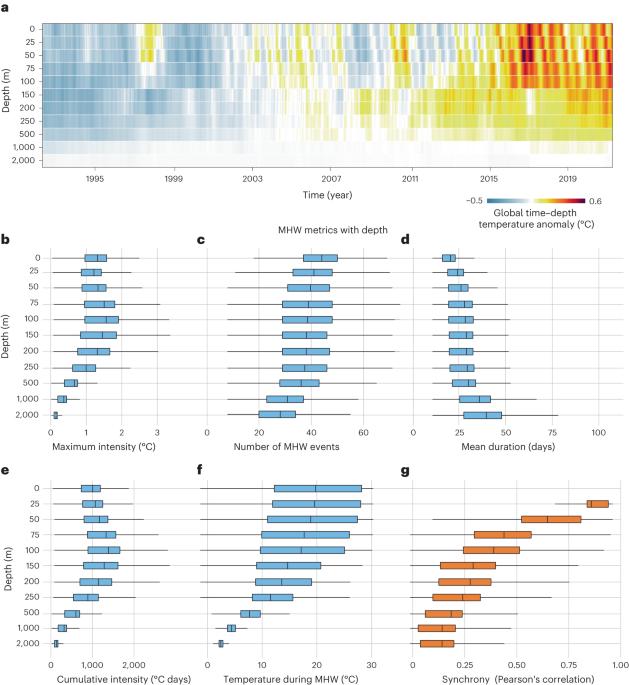Marine biodiversity exposed to prolonged and intense subsurface heatwaves
IF 29.6
1区 地球科学
Q1 ENVIRONMENTAL SCIENCES
引用次数: 0
Abstract
Marine heatwaves (MHWs) are becoming increasingly common, with devastating ecosystem impacts. However, MHW understanding has almost exclusively relied on sea surface temperature with limited knowledge about their subsurface characteristics. Here we estimate global MHWs from the surface to 2,000 m depth, covering the period 1993–2019, and explore biodiversity exposure to their effects. We find that MHWs are typically more intense in the subsurface at 50–200 m and their duration increases up to twofold with depth, although with large spatial variability linked to different oceanographic conditions. Cumulative intensity (a thermal stress proxy) was highest in the upper 250 m, exposing subsurface biodiversity to MHW effects. This can be particularly concerning for up to 22% of the ocean, where high cumulative intensity overlapped the warm range edge of species distributions, thus being more sensitive to thermal stress. Subsurface MHWs can hence drive biodiversity patterns, with consequent effects on ecological interactions and ecosystem processes. The authors estimate the intensity, duration and number of global marine heatwaves from 1993 to 2019, from the surface to 2,000 m. They show generally higher intensity of marine heatwaves at 50–200 m, but increased duration with depth, and predict ocean regions of higher biodiversity exposure.

海洋生物多样性暴露在长期和强烈的地下热浪中
海洋热浪(MHWs)越来越常见,对生态系统造成了破坏性影响。然而,人们对海洋热浪的了解几乎完全依赖于海面温度,对其次表层特征的了解十分有限。在此,我们估算了 1993-2019 年期间从海面到 2000 米深处的全球 MHWs,并探讨了生物多样性受其影响的情况。我们发现,在 50-200 米深的次表层,MHW 通常更为剧烈,其持续时间随深度增加最多可达两倍,但与不同海洋条件相关的空间变异很大。累积强度(热应力替代物)在上 250 米处最高,使亚表层生物多样性受到 MHW 的影响。这对于多达 22% 的海域尤为重要,在这些海域,高累积强度与物种分布的暖区边缘重叠,因此对热应力更为敏感。因此,表层下 MHW 可推动生物多样性模式,从而对生态相互作用和生态系统过程产生影响。作者估算了 1993 年至 2019 年全球海洋热浪的强度、持续时间和数量(从海面到 2000 米),结果显示 50-200 米处的海洋热浪强度普遍较高,但持续时间随深度增加,并预测了生物多样性暴露程度较高的海洋区域。
本文章由计算机程序翻译,如有差异,请以英文原文为准。
求助全文
约1分钟内获得全文
求助全文
来源期刊

Nature Climate Change
ENVIRONMENTAL SCIENCES-METEOROLOGY & ATMOSPHERIC SCIENCES
CiteScore
40.30
自引率
1.60%
发文量
267
审稿时长
4-8 weeks
期刊介绍:
Nature Climate Change is dedicated to addressing the scientific challenge of understanding Earth's changing climate and its societal implications. As a monthly journal, it publishes significant and cutting-edge research on the nature, causes, and impacts of global climate change, as well as its implications for the economy, policy, and the world at large.
The journal publishes original research spanning the natural and social sciences, synthesizing interdisciplinary research to provide a comprehensive understanding of climate change. It upholds the high standards set by all Nature-branded journals, ensuring top-tier original research through a fair and rigorous review process, broad readership access, high standards of copy editing and production, rapid publication, and independence from academic societies and other vested interests.
Nature Climate Change serves as a platform for discussion among experts, publishing opinion, analysis, and review articles. It also features Research Highlights to highlight important developments in the field and original reporting from renowned science journalists in the form of feature articles.
Topics covered in the journal include adaptation, atmospheric science, ecology, economics, energy, impacts and vulnerability, mitigation, oceanography, policy, sociology, and sustainability, among others.
 求助内容:
求助内容: 应助结果提醒方式:
应助结果提醒方式:


